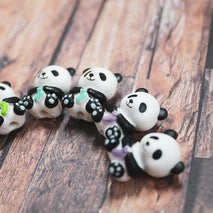This Hot Water Bottle Bobble Cover by Emily Bolduan, which is available as a free Ravelry download, can be knitted in the round or flat, depending on your preference. By choosing to knit in the round, you won’t have to worry about sewing the seams together, giving the cover a more polished look once complete.
Pattern: Hot Water Bobble by Emily Bolduan
Yarn: BaaRamEwe Winterburn DK - Aire x 1 skein
Needles: 4mm & 3.25mm interchangeable needles, and an interchangeable cable
Other accessories used: darning needle, scissors, and stitch markers
Getting Started with Judy's Magic Cast-On
If you choose to knit in the round for this project, you’ll need to use Judy’s magic cast on, a method often used for toe-up socks that won’t leave you with an uncomfortable seam along the toe of a sock. Casting on in this manner can be a bit tricky to master but, once you have it, can be a lifesaver and save lots of time that would otherwise be spent sewing up bottoms seams.
Check out our video on how to do Judy's Magic Cast On if you need a more visual guide to follow, especially if you've never attempted this method before.
Knitting The Hot Water Bottle Cover Pattern
This project shouldn’t take you long and takes shape very quickly. Being a simple knitting pattern, this hot water bottle cover is a great way to learn how to knit bobbles.

The pattern is incredibly easy to customise without major adjustments, which comes in handy for hot water bottles of different sizes. Make sure to keep a hot water bottle nearby to guarantee a snug fit! The cover’s neck should also remain flexible enough to remove your water bottle, making it simple to clean either the cover or the water bottle itself.
A customised hot water bottle cover can be a great gift for birthdays or Christmas, especially in the cold winter months. It’s also a good challenge for new knitters looking for something a little different.
If you’ve found this blog helpful and give Emily’s pattern a go, tag Crafty Llama on Instagram so we can see your amazing hot water bottle covers. All of the tools you need to complete this project are available in our Knitting Shop.
Happy knitting!





















